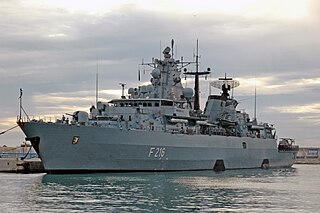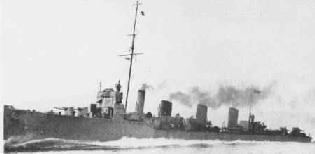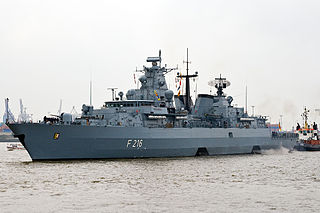Related Research Articles

Five ships of the Royal Australian Navy (RAN) have been named HMAS Sydney, after Sydney, the capital city of New South Wales.

The Imperial German Navy or the Imperial Navy was the navy of the German Empire, which existed between 1871 and 1919. It grew out of the small Prussian Navy, which was mainly for coast defence. Kaiser Wilhelm II greatly expanded the navy. The key leader was Admiral Alfred von Tirpitz, who greatly expanded the size and quality of the navy, while adopting the sea power theories of American strategist Alfred Thayer Mahan. The result was a naval arms race with Britain, as the German navy grew to become one of the greatest maritime forces in the world, second only to the Royal Navy.
Brandenburg is one of Germany's sixteen Bundesländer.

SMS Bayern was the lead ship of the Bayern class of battleships in the German Kaiserliche Marine. The vessel was launched in February 1915 and entered service in July 1916, too late to take part in the Battle of Jutland. Her main armament consisted of eight 38 cm (15 in) guns in four turrets, which was a significant improvement over the preceding König's ten 30.5 cm (12 inch) guns. The ship was to have formed the nucleus for a fourth battle squadron in the High Seas Fleet, along with three of her sister ships. Of the other ships only one—Baden—was completed; the other two were canceled later in the war when production requirements shifted to U-boat construction.

Howaldtswerke-Deutsche Werft is a German shipbuilding company, headquartered in Kiel. It is part of the ThyssenKrupp Marine Systems (TKMS) group, owned by ThyssenKrupp. The Howaldtswerke shipyard was founded in Kiel in 1838 and merged with Hamburg-based Deutsche Werft to form Howaldtswerke-Deutsche Werft (HDW) in 1968. The company's shipyard was formerly used by Friedrich Krupp Germaniawerft until the end of World War II.
Aktien-Gesellschaft Vulcan Stettin was a German shipbuilding and locomotive building company. Founded in 1851, it was located near the former eastern German city of Stettin, today Polish Szczecin. Because of the limited facilities in Stettin, in 1907 an additional yard was built in Hamburg. The now named Vulcan-Werke Hamburg und Stettin Actiengesellschaft constructed some of the most famous civilian German ships and it played a significant role in both World Wars, building warships for the Kaiserliche Marine and the Kriegsmarine later.

The F123 Brandenburg class is a class of German frigate. They were ordered by the German Navy in June 1989 and completed and commissioned between 1994 and 1996, replacing the Hamburg-class destroyers. The ships primarily carry out anti-submarine warfare (ASW), but they also contribute to local anti-aircraft defenses, the tactical command of squadrons, and surface-to-surface warfare operations. Together with the F124 Sachsen class frigates, they are the mainstay of the German surface fleet.
Several ships of the Chilean Navy have been named Almirante Latorre after Juan José Latorre:
Saxony is a historical region in Germany and a federal state.

SMS Bayern was one of four Sachsen-class armored frigates of the German Imperial Navy. Her sister ships were Sachsen, Baden, and Württemberg. Named for Bavaria, Bayern was built by the Imperial Dockyard in Kiel from 1874 to 1881. The ship was commissioned into the Imperial Navy in August 1881. She was armed with a main battery of six 26 cm (10.2 in) guns in two open barbettes.
There have been two ships in the German Imperial Navy named SMS Württemberg:

HMS Broke was a Faulknor-class destroyer leader of the Royal Navy, initially built for the Chilean Navy as the Almirante Lynch-class destroyer Almirante Goñi. The outbreak of the First World War led to her being purchased by the Admiralty in August 1914 shortly after her launching, and renamed HMS Broke. All of the class were present at the Battle of Jutland on 31 May to 1 June 1916 where Broke, out of control after hits from German ships, collided with the Acasta-class destroyerHMS Sparrowhawk leading to the latter's loss. Broke saw action in several battles, and was resold to Chile after the conclusion of the war.
Bayern is the German name for Bavaria, one of the 16 states of Germany.
Several naval ships of Germany were named Hessen after the state of Hesse, Germany :
Several naval ships of Germany were named Schleswig-Holstein after the federal state of Schleswig-Holstein:
Several naval ships of Germany were named Sachsen after the federal state of Saxony:

Schleswig-Holstein is a Brandenburg-class frigate of the German Navy.
A number of vessels of the German Navy have borne the name Hipper, after Franz von Hipper.
References
- ↑ dreadnaughtz666 (2018-04-13). "Bayern class battleships (1916)". naval encyclopedia. Retrieved 2020-11-08.
- ↑ "Type 123 Brandenburg class Frigate German Navy". seaforces.org. Retrieved 2020-11-08.